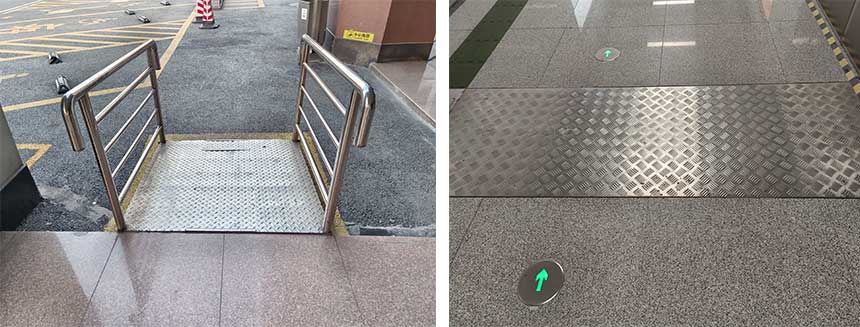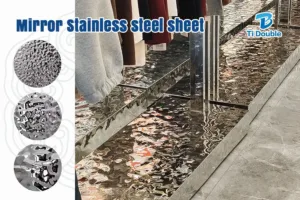Stainless steel is a popular material used in many industries because of its durability and resistance to corrosion. But sometimes, plain stainless steel can look a bit dull, and you may want to add some texture or design to make it more visually appealing or functional. This is where embossing stainless steel comes in. By pressing specific patterns into the surface of stainless steel, you can enhance its look while also adding strength and slip resistance.
In this article, we’ll explain the embossing process, its applications, and its benefits in easy-to-understand language.
1. What is Embossing Stainless Steel?
Embossing stainless steel is the process of creating raised or recessed patterns on its surface. This can be done using mechanical or chemical methods. The embossing process improves both the appearance and the performance of stainless steel, making it stronger and more resistant to slipping.

Why Use Embossed Stainless Steel?
Stainless steel is already well-known for being resistant to rust and having a long lifespan. However, when you emboss it, it gains extra benefits. The textured surface not only looks more attractive but also helps hide fingerprints and smudges, which means less cleaning. This makes it especially useful in places where stainless steel is frequently touched, like in kitchens and elevators.
2. The Embossing Process
Embossing stainless steel typically involves a mechanical process where a sheet of stainless steel is placed between two rollers or dies. These dies have a specific pattern, and when the steel is pressed between them, the pattern gets imprinted onto the surface.
Steps in the Embossing Stainless Steel Process:
- Design the Pattern: The first step is to create the design that will be pressed onto the stainless steel. This could be simple shapes or more complex, custom designs like a company logo.
- Tooling Preparation: Special dies are made based on the design, and the stainless steel is prepared for embossing.
- Embossing the Steel: The stainless steel sheet is placed into a machine where pressure is applied to press the pattern onto its surface.
- Finishing: After embossing, the stainless steel can be polished or brushed to enhance its appearance.

Types of Embossing
- Mechanical Embossing: This is the most common method, using machines to apply pressure and create the pattern. It’s ideal for large quantities and simple designs.
- Chemical Embossing: This method uses chemicals to etch the surface, creating a design. It’s not as common for stainless steel but is used for more detailed designs.
3. Types of Stainless Steel Used for Embossing
Not all types of stainless steel are suitable for embossing. The two most commonly used types are:
Grade 304 Stainless Steel
This is the most widely used type of stainless steel. It has excellent resistance to corrosion and is easy to work with, making it perfect for embossing detailed designs. Grade 304 is commonly found in kitchen equipment and building materials.
Grade 316 Stainless Steel
Grade 316 is more resistant to corrosion than Grade 304, especially in environments exposed to chemicals or saltwater. It’s often used for embossing stainless steel used in harsh environments, such as marine or industrial applications.
4. Common Applications of Embossed Stainless Steel
Embossed stainless steel is used in a wide range of industries. Here are some of the most common uses:
4.1 Architecture and Interior Design
Embossed stainless steel is very popular in architecture and interior design because it looks good and lasts a long time. It is commonly used for:
- Building Facades: The textured surface adds visual interest to the outside of buildings while also providing protection.
- Elevator Panels: Embossed stainless steel is used in elevators to prevent visible wear and tear while keeping a modern look.
- Interior Wall Panels: In commercial spaces, embossed stainless steel is used to create a sleek, high-end appearance.

4.2 Industrial and Commercial Uses
Embossed stainless steel is also widely used in industrial and commercial environments, mainly for its functionality.
- Flooring: The textured surface provides better grip, making it ideal for industrial floors where safety is important.
- Machinery and Equipment: Embossing adds extra strength to the steel, making it more durable for machine casings and equipment housing.
4.3 Food and Beverage Industry
In the food industry, materials need to be easy to clean and resistant to corrosion. Embossed stainless steel is perfect for this.
- Food Processing Equipment: The raised texture makes the surface easier to clean, preventing food from sticking to it.
- Packaging Machines: Embossed stainless steel is durable and easy to sanitize, making it ideal for food packaging machinery.
5. Benefits of Embossed Stainless Steel
There are several key advantages to using embossed stainless steel, making it a popular choice in many industries:
Enhanced Durability
The embossing process strengthens the surface of the stainless steel, making it more resistant to dents and impacts. This is especially important in industrial environments where equipment is heavily used.
Improved Aesthetic Appeal
Embossing adds texture and depth to the surface, making it more visually appealing. Whether used for decorative wall panels or building exteriors, embossed stainless steel gives a polished and professional look.
Easy to Maintain
The textured surface helps hide fingerprints, smudges, and scratches, meaning less frequent cleaning is required. This is especially useful in high-traffic areas like commercial kitchens or public buildings.
Slip Resistance
In places where safety is a concern, like industrial floors or public walkways, the textured surface of embossed stainless steel provides extra grip, reducing the risk of slipping.

6. Challenges of Embossing Stainless Steel
While embossed stainless steel has many advantages, there are also some challenges to consider:
- Cost: The embossing process, especially for custom designs, can be more expensive than using plain stainless steel sheets. However, the long-term benefits often outweigh the initial cost.
- Precision: Maintaining consistent patterns on large sheets of stainless steel can be tricky, especially if the material is very thick or hard. This requires skilled operators and high-quality machinery.
7. How to Choose an Embossed Stainless Steel Supplier
If you’re thinking about using embossing stainless steel for your project, it’s important to work with a supplier who has experience in this field. Here’s what to look for:
- Customization Options: The supplier should be able to offer custom designs that match your project’s needs.
- Quality Assurance: Make sure the supplier has a track record of producing high-quality embossed stainless steel with consistent patterns.
- Industry Expertise: Choose a supplier who understands your industry and can recommend the best materials and embossing techniques for your application.
Conclusion
Embossing stainless steel is an innovative and versatile way to enhance both the look and functionality of stainless steel. Whether you are designing a modern building facade, upgrading an industrial workspace, or creating non-slip flooring, embossed stainless steel offers the perfect combination of style and performance. By understanding the process and its benefits, you can make the best decision for your next project.
Frequently Asked Questions (FAQ)
1. What is the purpose of embossing stainless steel?
Embossing stainless steel enhances both its appearance and functionality. It adds decorative patterns to the surface while improving durability and slip resistance. This makes it ideal for applications where both looks and practicality are important, like in architecture, industrial flooring, and food processing equipment.
2. Can any type of stainless steel be embossed?
No, not all stainless steel grades are suitable for embossing. The most commonly used types are Grade 304 and Grade 316 stainless steel. These grades are chosen for their durability, corrosion resistance, and formability, which make them ideal for the embossing process.
3. What are the benefits of using embossed stainless steel?
Embossed stainless steel offers several key benefits, including:
Improved aesthetics: The textured surface is more visually appealing.
Durability: Embossing adds strength, making it more resistant to wear and impact.
Easy maintenance: The pattern helps hide fingerprints and scratches, reducing cleaning.
Slip resistance: The texture provides better grip, making it safer for flooring applications.
4. What industries commonly use embossed stainless steel?
Embossed stainless steel is widely used in various industries, including:
Architecture: For building facades, interior wall panels, and elevator cladding.
Industrial: For slip-resistant flooring, equipment housing, and machinery.
Food and Beverage: For food processing equipment and sanitary surfaces.
Automotive: In manufacturing for parts that require added strength and texture.
5. How is the embossing process done?
The process involves passing a sheet of stainless steel through rollers or dies that are designed with the desired pattern. Pressure is applied to imprint the pattern onto the surface of the metal. There are also chemical embossing methods, but they are less common for stainless steel.



